Are you taking extra care of your indoor plants in summer? Well, you should.
In summer, your indoor plants need a little extra care and attention.
Of course, they also get hot and thirsty at other times as well.
No doubt indoor plants add beauty to your place in every season and don’t ask for much in return. But in the summer months, they do crave for your attention and care.
So, show them some love and affection with these simple indoor plant care tips for summer.
Read on to discover tips on how to take care of your indoor plant in summer including how you should water your indoor plant in summer and indoor plant selection.
10 Tips to Take Care of your Indoor Plants in Summer
Tip 1: Move your Plant away from the Sun
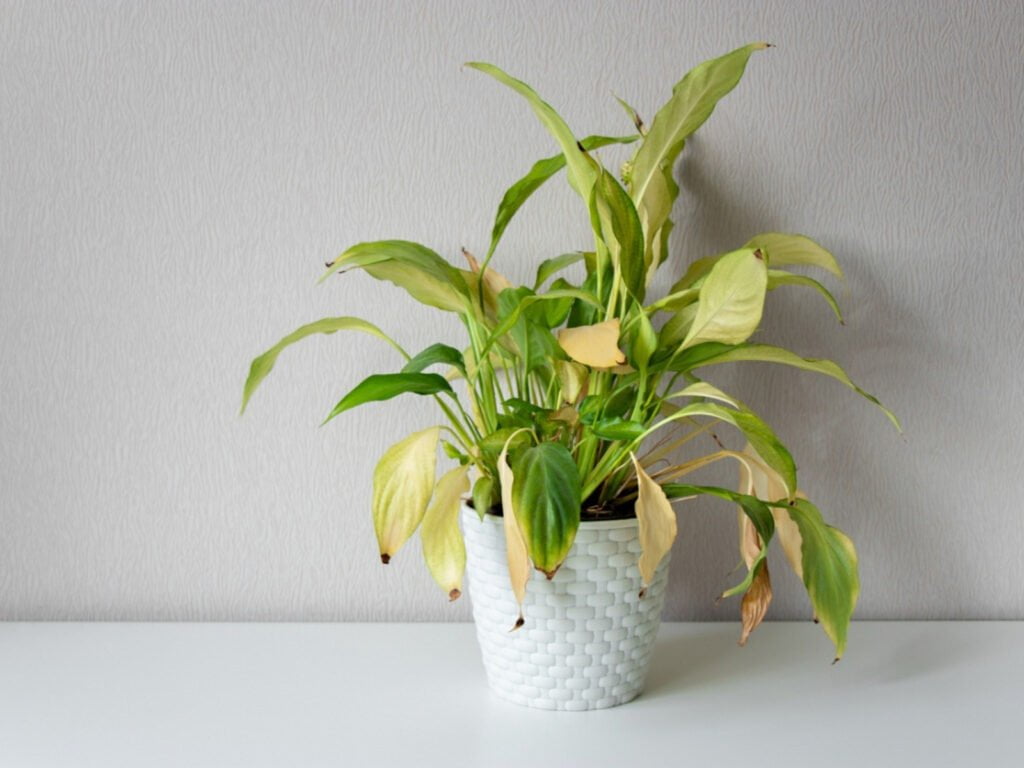
Do you know plants that usually love bright sunlight, can get overwhelmed by too much heat and sun in the summer?
You can spot their unhappiness by noticing the wilted leaves and pale foliage. If you observe carefully you will see some rough patches developing on the leaves because of sunburn.
So, save your plant by moving them further away from sun-filled windows during summer. You can also put up a sheer curtain in between them.
Tip 2: Keep your indoor plants cool
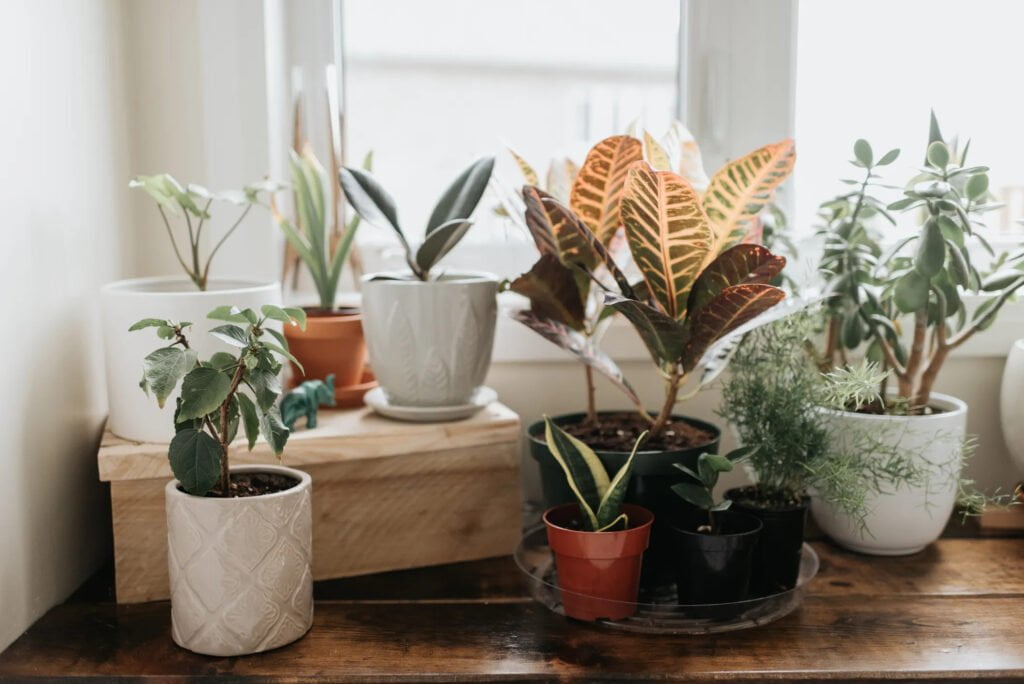
Just like people, plants also like fresh air in the summer.
So let them enjoy the breeze by opening windows during the cooler times of the day.
However, do not put them in front of an air conditioner. Most indoor plants do not like cold air directly hitting on their leaves.
Tip 3: Keep your plant clean and pests free

Of course, opening the window will bring fresh air, but it will also invite unwanted dust, pollen, and sometimes pests.
Settled dust on the foliage blocks the air and prevents the sunlight from reaching the plant which is essential for their growth.
However, it is easy to clean the dust from your indoor plant. You only need to schedule a weekly “bath time” for them. Use a damp cloth or paper towel to gently clean the dust from the foliage.
For plants that are thick and shiny, for example, Ficus, a damp sponge is the best.
Moreover, avoid using water on fuzzy leaves and cacti. You can use a soft dry paintbrush to clean them.
In addition, check your plant for sneaky pests like gnats, mealybugs, and mites. Their favorite places are the soil, and the undersides of leaves, so do check these parts of the plant.
The signs you can notice are speckles, pale spots, or silky or cottony webs. If you spot these signs, immediately clean and remove the ailing plant and separate it from other plants until the infected plant is diagnosed.
Tip 4: Frequently water your plant
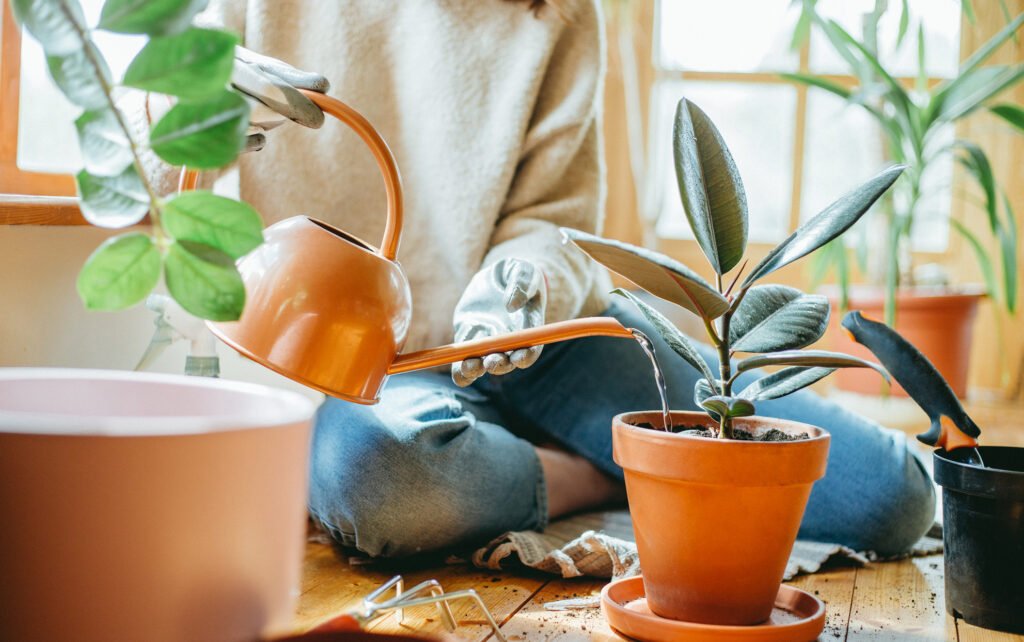
You must have heard many times that you should not overwater your plant!
However, when the temperature rises in the summer, the above advice needs to be changed a little bit.
During summer, your plants need frequent watering.
In summer, water evaporates faster than normal. You will observe the soil dries out quickly and your plants require watering again and again.
Don’t use cold water, you might think that it will help your plant to cool but cold water shocks the plant roots.
You can consider room temperature water. They are the best and a good deep soak with it will help your plant to get through the day.
Still, it doesn’t mean that you have to overwater your plant. You need to keep the balance between overwatering and underwatering.
The below table will help you identify the signs of overwatering and underwatering
| Signs of underwatering | Signs of overwatering |
| Slow leaf growth Translucent leaves Premature dropping of flowers or leaves Brown, yellow, or curled leaf edges | Fungus or mold on the soil surface Mushy brown roots Standing water Young and old leaves falling off Leaves with brown rotten patches |
Plant watering demands
| Plant requiring less water | Plant requiring more water |
| Flowering plants Plants potted in clay pots Plants grown in small pots Actively growing plants Plants located in direct sunlight Large-leaved or thin-leaved plants Plants that are native to wet areas. | Dormant plants Recently repotted plants Plants grown in high humidity Plants located in a cool room Plants potted in a non-porous pot Plants with thick or rubbery leaves Plants grown in a water-retentive mix |
Tip 5: Promote high humidity

Keep the humidity high, especially around those tropical plants that enjoy high humidity.
The quick and easy method to promote high humidity is by setting up a humidity tray.
Put an upside-down saucer in the middle of a deep plate. Fill the plate with water. Now, put your plant on the top of the saucer. It will raise the humidity as the water starts to evaporate. The point to remember here is not to allow water to touch the bottom of the pot.
The next option is a pebble tray. Put the pot on a tray that is filled with water and pebbles. Again, do not keep the pot above the water.
Another great option you can consider to help your plant in summer is to purchase a small humidifier and place it around your plants.
Tip 6: Fertilize or not

For most plants, spring and summer are the growing seasons. During the growing season, new shoot emerges, and flowers bloom. During this time of the year, you should give your plant energy boosters and fertilizers.
Beware! when regular summer days turn into hot days. At this point, the plants get into survival mode.
At this time, all the energy of the plants goes into coping with the high temperatures instead of taking in nutrients.
During scorching summer, fertilizer can be too much to handle for your plant. Worse is when your plant’s leaves start to burn. So, wait for the heatwaves to end before fertilizing the plant again.
Tip 7: Hold off on Repotting
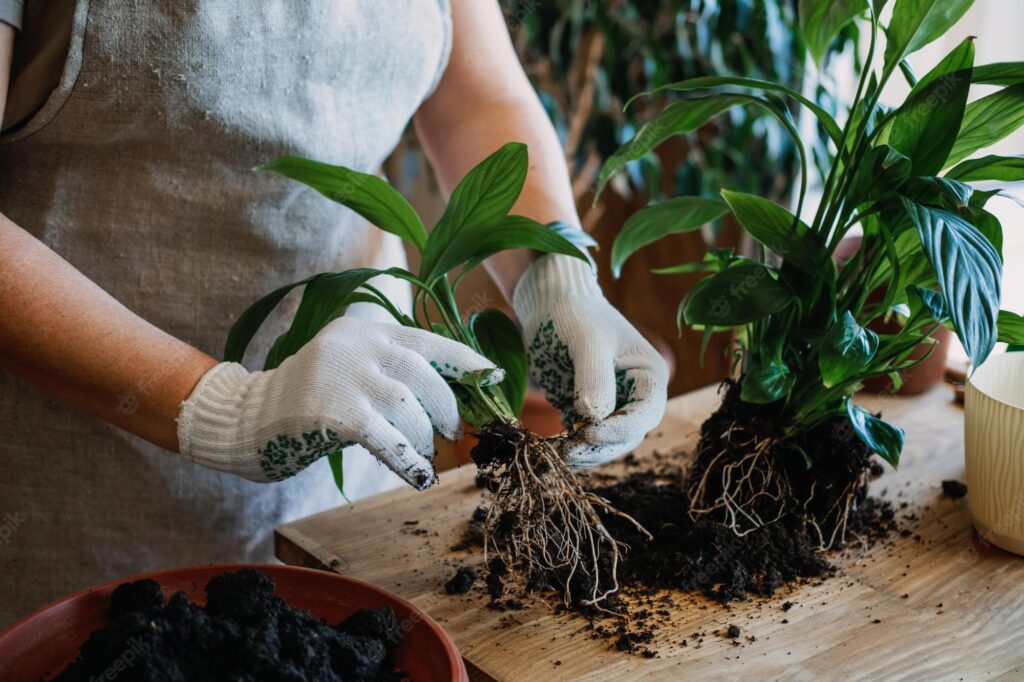
The same story, during summer your plants need the energy to deal with heat and sun.
Repotting in hot summer will cause your plant unnecessary stress to the roots of the plant.
If possible, wait for little cooler days to repot your plant.
Tip 8: Avoid significant pruning
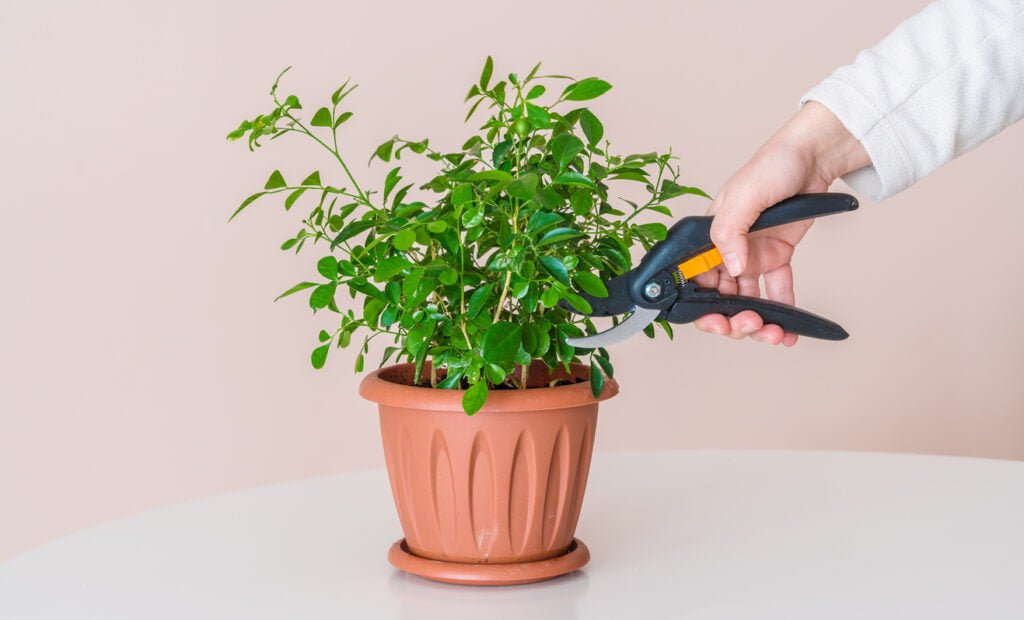
Like repotting, plants need pruning to promote new growth and maintain their shape. But pruning is also stressful for plants.
So, wait until the temperatures drop a little to do the trimming.
Tip 9: Check your indoor plant more often

Get into the habit of checking the moisture level of the plant more often than you usually do. The best way to check the plant is to feel the soil and water it when the soil is dry a few inches below the surface.
You can get a small moisture meter to test your indoor plant, they are quite unreliable. If you have placed your indoor plant near the air conditioner, then remember that they dry out quickly due to lack of humidity.
Tip 10: Watch for signs of summer stress
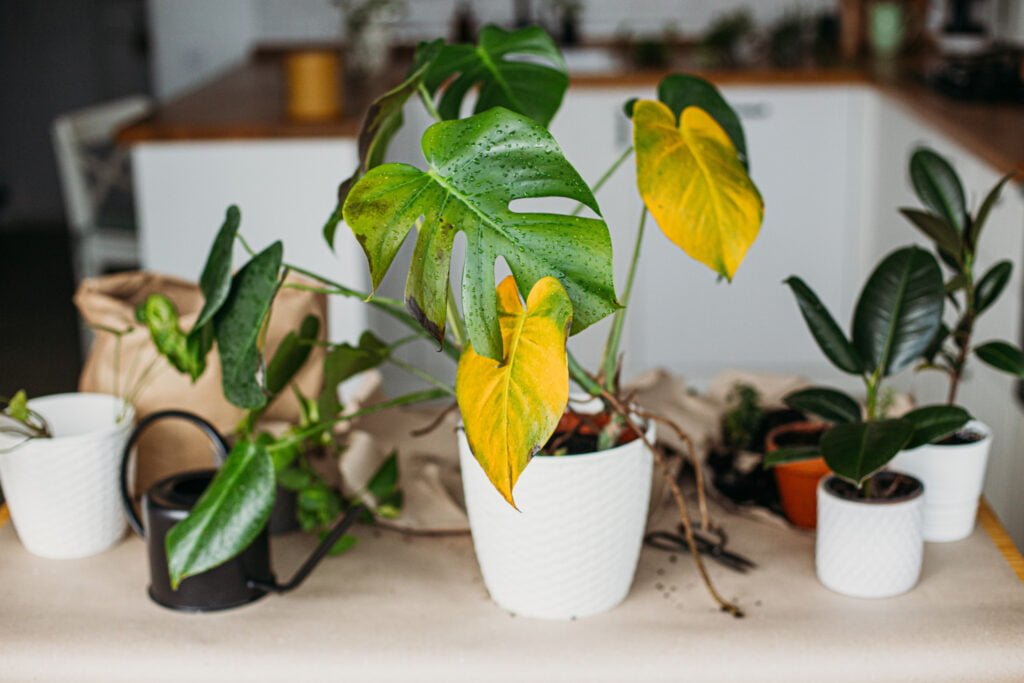
Catch the problems early due to the hot summer by watching for stress signs so that you can adjust your plant before they suffer permanent damage.
Common stress signs include:
- Wilted leaves
- Pale, yellow, or brown leaves
- Rough brown patches
- Leaves and flowers dropping off.
How to water your indoor plant in summer?
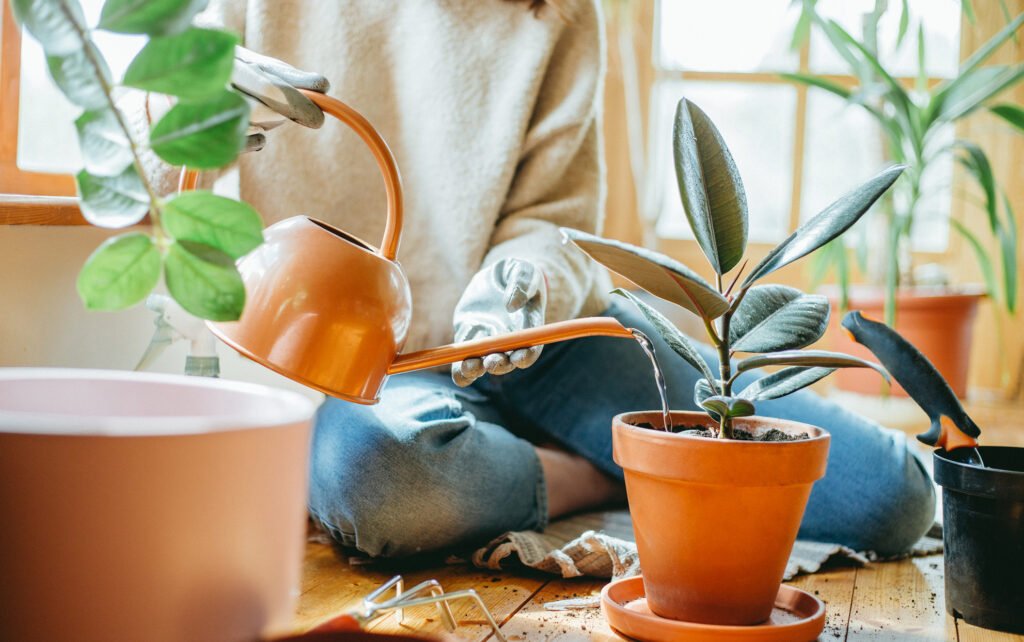
You can water the plant from the top-down or bottom-up. While watering from the top, do not wet the plant foliage first and ensure that the soil is moist.
Moreover, it is important that water should come out of the drainage hole from the bottom of the container, so water thoroughly.
If you are busy and prefer to let your plant do the watering work, set the plant in a dish of water and the roots will pull up whatever they need. This is called the bottom-watering method.
Also, make sure to dump any standing water from the dish one hour after watering.
Along with watering, good drainage is also important for indoor plants. So, start with a good quality of organic potting soil that has been mixed for indoor plants.
Choose a pot with drainage holes, or put a layer of pebbles in the bottom of a pot which doesn’t have holes. Check the drainage holes periodically to ensure that they are not clogged. Don’t let standing water go back into the soil and don’t run it through the plant again.
Should you fertilize an indoor plant in summer?
Spring and summer are the best time to fertilize indoor plants. You only need to fertilize indoor plants 3 to 4 times per year- March, May, July, and September.
Select a fertilizer or plant food with a balanced ratio of nitrogen, phosphorus, and potassium and apply half of its strength.
However, do not fertilize your indoor plants on a hot or dry day, or if your plants are stressed. Fertilizing a plant that is already stressed by summer heat will only make it worse. You should wait until it cools down before fertilizing.
How to select the indoor plant?

The first question to ask while selecting the indoor plant is where you want to place it?
Next, match the lighting, space, and other plant requirements.
Like, do you have a large space by a sunny window or a small space with moderate sunlight?
Now, ask yourself if you want an indoor plant with beautiful green leaves or a flowering plant. Some flowering indoor plant thrives well in summer.
For example, Lilies, Marigolds, Roses, Bougainvillea, dahlia, sunflower, etc. enjoy the summertime and flower during that season.
The third consideration is how much time you can give to your particular plant. Some plants take any amount of care, while some require significant tender and loving care like orchids.
FAQs
Ques 1. Should I water my indoor plant every day in the summer?
Even during the hottest days of summer, soaking plants every three or four days will keep them healthier and cooler because it forces the roots deeper into the soil where they can thrive.
Ques 2. When should I water my indoor plants?
Early morning is the optimal time to water your plant, as it is cooler at that time.
This will allow more water to reach the root before it evaporates in the heat. If you are unable to water your plants in the morning, schedule them for a later time.
In this case, water the plants in the late evening before going to bed.
Ques 3. What happens when the plant gets too hot?
The symptoms of heat stress show up in the form of wilting, which indicates excessive water loss.
Ques 4. Can indoor plants recover from heat stress?
Yes, many plants recover when temperatures drop. If a plant remains wilted for a long time, it is more likely to suffer permanent damage.
Ques 5. Should I cut off Sunburned leaves?
Sunburned leaves will eventually fall off on their own, so you don’t need to cut them off. However, removing the leaves having more than 50% damage will improve the overall appearance of the plant.
Ques 6. Does an indoor plant need fertilizer in summer?
Most indoor plants do not need fertilizer in summer, especially during hot, dry spells.
Ques 7. Which fertilizer should you use in summer for indoor plants?
Apply a fertilizer containing nitrogen, phosphorus, and potassium during summer. Indoor plants’ fertilizers are available in liquid, crystalline, granular, spike, and tablet forms.
Conclusion
During the summer, the sun has an insidious effect on indoor plants. After being in the sun for a few minutes, sunburn spots start to appear on the leaves.
By that time, it is too late to rescue the plant. There is nothing you can do to help the plant except offer kind words of apology.
When sudden changes in the weather occur, heat can potentially be detrimental to indoor plants.
Therefore, it is important to take extra effort and care for your plant in summer to keep them healthy and blooming.
The above-mentioned care tips will surely help saving your plant from the scorching sun.







